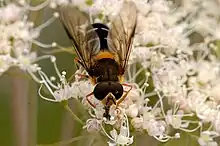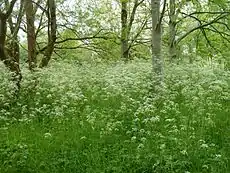| Leucozona glaucia | |
|---|---|
 | |
| Male | |
.jpg.webp) | |
| Female | |
| Scientific classification | |
| Domain: | Eukaryota |
| Kingdom: | Animalia |
| Phylum: | Arthropoda |
| Class: | Insecta |
| Order: | Diptera |
| Family: | Syrphidae |
| Genus: | Leucozona |
| Subgenus: | Ischyrosyrphus |
| Species: | L. glaucia |
| Binomial name | |
| Leucozona glaucia | |
| Synonyms | |
Leucozona glaucia, the Pale-saddled Leucozona[1] is a Palearctic hoverfly. Larvae feed on ground layer aphids. Adults are usually seen visiting flowers.[2][3][4]
Description
External images
For terms see Morphology of Diptera
Wing length 8-11·25 mm. Scutellum yellow. Tergite 2 has large silverish-white to yellowish- white marks (often merged). Tergites 3 and 4 have narrow or absent markings.
The male genitalia are figured by Dusek and Laska (1967) .[5] The larva is figured by (Dusek and Laska (1962) [6]
See references for determination
[7]
[8]
[9][10]
Distribution
The species has a Palearctic distribution from Fennoscandia south to the Pyrenees, from Ireland east through central Europe into Turkey and European Russia, Russian Far East and Siberia and the Pacific coast (Kuril Islands and Japan).[11][12]

Biology
The species' habitat includes Quercus and Fagus forest, riverine gallery forest of Fraxinus and Salix, beside streams, in clearings and along tracks.[13] Flowers visited include white umbellifers, Filipendula, Sambucus and Senecio.[14] The flight period is May to September, with the peak in July and August. The larvae feed on aphids.
References
- ↑ "Birmingham & Black Country SPECIES ATLAS SERIES" (PDF).
- ↑ Ball, S.G.; Morris, R.K.A. (2000). Provisional atlas of British hoverflies (Diptera, Syrphidae). Monks Wood, UK: Biological Record Centre. pp. 167 pages. ISBN 1-870393-54-6.
- ↑ Morris, Roger, K. A. (1999). Hoverflies of Surrey. Surrey Wildlife Trust. p. 244. ISBN 0-9526065-3-4.
{{cite book}}: CS1 maint: multiple names: authors list (link) - ↑ Stubbs, Alan E.; Falk, Steven J. (1983). British Hoverflies: An Illustrated Identification Guide. British Entomological & Natural History Society. p. 253, xvpp.
- ↑ Dusek, J. & Laska, P. (1967) Versuch zum aufbau eines Naturlichen Systems mitteleuropaischer Arten der Unterfamilie Syrphinae (Diptera). Acta sc. nat. Brno, 1: 349-390.
- ↑ Dusek, J. & Laska, P. (1962) Beitrag zur Kenntnis einiger Syrphiden-larven (Diptera, Syrphidae). Acta Soc. Ent. Cechosloveniae, 59: 348-356.
- ↑ Van Veen, M. (2004) Hoverflies of Northwest Europe: identification keys to the Syrphidae. 256pp. KNNV Publishing, Utrecht.addendum
- ↑ Van der Goot,V.S. (1981) De zweefvliegen van Noordwest - Europa en Europees Rusland, in het bijzonder van de Benelux. KNNV, Uitgave no.32: 275pp. Amsterdam.
- ↑ Bei-Bienko, G.Y. & Steyskal, G.C. (1988) Keys to the Insects of the European Part of the USSR, Volume V: Diptera and Siphonaptera, Part I. Amerind Publishing Co., New Delhi. ISBN 81-205-0080-6.
- ↑ Coe, R.L. (1953) Diptera: Syrphidae. Handbks.ident.Br.insects, 10(1): 1-98. R.ent.Soc.London. pdf
- ↑ Fauna Europaea
- ↑ Peck, L.V. (1988) Syrphidae. In: Soos, A. & Papp, L. (eds.) Catalogue of Palaearctic Diptera, 8: 11-230. Akad.Kiado, Budapest.
- ↑ Speight, M.C.D. (2011). "Species accounts of European Syrphidae (Diptera)" (PDF). Syrph the Net, the Database of European Syrphidae. 65: 285pp.
- ↑ de Buck, N. (1990) Bloembezoek en bestuivingsecologie van Zweefvliegen (Diptera, Syrphidae) in het bijzonder voor België. Doc.Trav. IRSNB, no.60, 1-167.